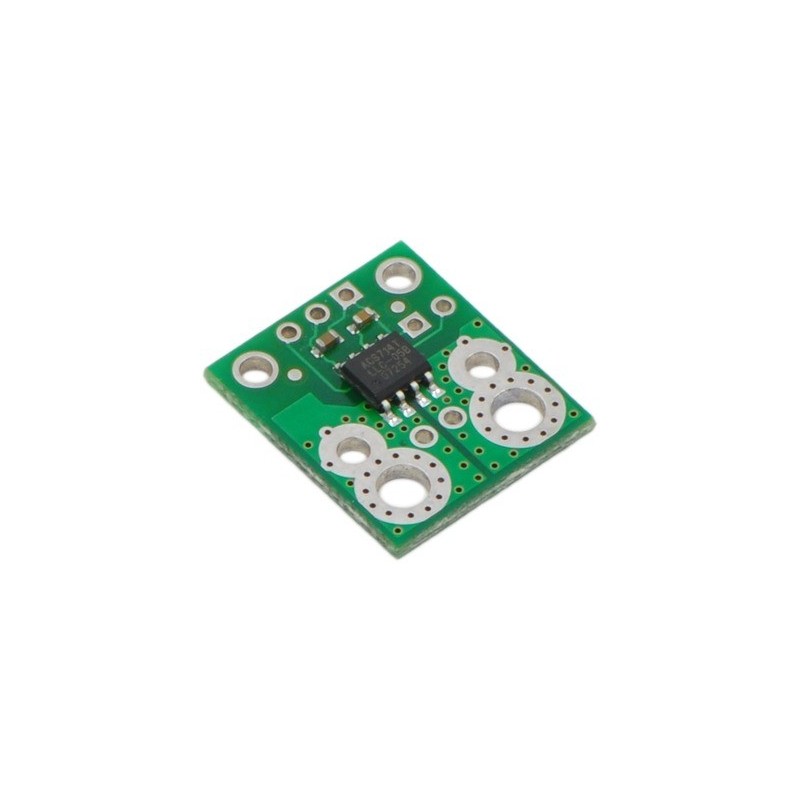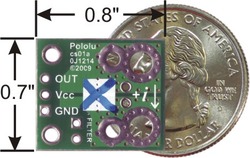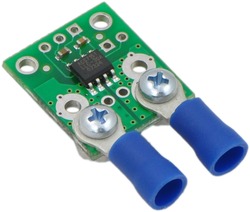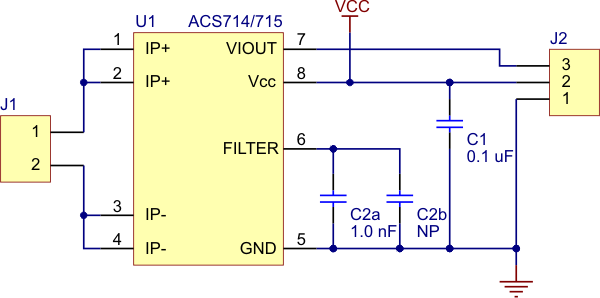

ACS714 Current Sensor Carrier -5 to +5A
This board is a simple carrier of Allegro’s ±5A ACS714 Hall effect-based linear current sensor, which offers a low-resistance (~1.2 m?) current path and electrical isolation up to 2.1 kV RMS. This version accepts a bidirectional current input with a magnitude up to 5 A and outputs a proportional analog voltage (185 mV/A) centered at 2.5 V with a typical error of ±1.5%. It operates from 4.5 to 5.5 V and is intended for use in 5 V systems.
 |
This current sensor is a carrier board or breakout board for Allegro’s ACS714LLCTR-05B-T Hall effect-based linear current sensor; we therefore recommend careful reading of the ACS714 datasheet (661k pdf) before using this product. The sensor operates at 5 V and has an output sensitivity of 185 mV/A. The board ships fully populated with its SMD components, including the ACS714, as shown in the product picture. The following list details some of the sensor’s key features:
The pads are labeled on the bottom silkscreen, as shown in the picture to the right. The silkscreen also shows the direction that is interpreted as positive current flow via the +i arrow.
Like almost all our carrier boards, this sensor ships assembled with all of its required surface mount components, as shown in the main product picture.
We sell a 30A unidirectional version and ±30A bidirectional version version of this board; you can distinguish these versions by reading the text on the IC or by looking at the color of the X on the bottom silkscreen. This version is marked with a blue X.
 |
| ACS715 current sensor carrier with solderless ring terminal connectors (not included). |
|---|
The sensor requires a supply voltage of 4.5 – 5.5 V to be connected across the Vcc and GND pads, which are labeled on the bottom silkscreen. The sensor outputs an analog voltage that is linearly proportional to the input current. When Vcc is 5 V, this output voltage is centered at 2.5 V and changes by 185 mV per amp of input current, with positive current increasing the output voltage and negative current decreasing the output voltage.
The input current can be connected to the board in a variety of ways. For low-current applications, you can solder 0.1" male header pins to the board via the small through-holes on the input-current side of the board. For higher-current applications, you can solder wires directly to the through-holes whose sizes best match your wires, or you can use solderless ring terminal connectors, as shown in the picture to the right. The large through-holes are big enough for #6 screws.
The board has two mounting holes on the logic side of the board. These mounting holes are 0.5" apart and are designed for #2 screws.
The IC has an internal filter resistance of 1.7 kΩ, and the carrier board includes a 1 nF filter capacitor, which produces a low-pass RC filter with a 90 kHz cutoff. You can improve sensing system accuracy for low-frequency sensing applictations by adding a capacitor in parallel with the integrated 1 nF capacitor across the pads marked “filter” on the bottom silkscreen (this capacitor is labeled C2b in the schematic below). The frequency F that the filter will attenuate to half its original power is given by:
F = 1 / (2đRC) = 1 / (11kΩ * (1 nF + Cf))
where Cf is the value of the capacitor added to the filter pads.
 |
| Pololu ACS714/ACS715 current sensor carrier schematic diagram. |
|---|
 |
ACS714 Current Sensor Carrier -30 to +30A |
 |
ACS715 Current Sensor Carrier 0 to 30A |
 |
0.1" (2.54mm) Crimp Connector Housing: 1x3-Pin 25-Pack |
Manufacturer BTC Korporacja sp. z o. o. Lwowska 5 05-120 Legionowo Poland sprzedaz@kamami.pl 22 767 36 20
Responsible person BTC Korporacja sp. z o. o. Lwowska 5 05-120 Legionowo Poland sprzedaz@kamami.pl 22 767 36 20
ACS711EX Current Sensor Carrier -31A to +31A
Module with INA237 sensor designed for power monitoring. Allows measurement of voltages up to 85 VDC and current up to 10 A. Uses a 16-bit ADC for precise and accurate readings available via the I2C interface. Adafruit 6340
Module with an analog AC current sensor in a set with a probe for non-contact measurement of alternating current with a current of up to 10 A. DFRobot SEN0288
Module with an analog current sensor. Enables measurement of alternating and direct current up to 20 A. DFRobot SEN0214
The ACS72981 current sensor module uses the Hall effect to accurately and safely measure AC and DC current, providing electrical isolation of the current path. With a wideband analog output (up to 250 kHz) and low conduction resistance (0.2 mΩ), it minimizes energy loss and offers a fast response time of less than 2 µs. Pololu 5263
Compact current sensor based on TMR technology, enabling precise measurements up to 30 A with minimal energy losses. Thanks to a wide 1 MHz bandwidth, galvanic isolation and interference immunity, it is perfect for applications requiring fast response and high accuracy. Pololu 5305
The ACS72981 current sensor module uses the Hall effect to accurately and safely measure AC and DC current, providing electrical isolation of the current path. With a wideband analog output (up to 250 kHz) and low conduction resistance (0.2 mΩ), it minimizes energy loss and offers a fast response time of less than 2 µs. Pololu 5261
Crowtail – Current Sensor 2.0 enables AC/DC current measurement up to ±20 A using the ACS712 chip and generates an analog signal for further analysis. Used in energy-consumption monitoring systems, automation, and laboratory measurements.
Module with ACS723 current sensor with a measuring range of AC and DC ± 5 A. It communicates via an analog interface. SparkFun SEN-13679
The ACS72981 current sensor module uses the Hall effect to accurately and safely measure AC and DC current, providing electrical isolation of the current path. With a wideband analog output (up to 250 kHz) and low conduction resistance (0.2 mΩ), it minimizes energy loss and offers a fast response time of less than 2 µs. Pololu 5250
A compact Hall-effect current sensor that provides accurate DC and AC current measurement within a ±30 A range with galvanic isolation. It features a high-sensitivity analog VOUT output with a 150 kHz bandwidth, enabling fast and precise readings in dynamic systems. The module operates over a wide temperature range of -40°C to 125°C, and its low current path resistance (~1.6 mΩ) minimizes energy loss. Its small size and flexible mounting options make it ideal for prototyping, industrial systems, and space-constrained projects. Pololu 5451
No product available!
Module with ACS724LLCTR-10AU current sensor with a measuring range of direct and alternating current from 0 to 10 A. It communicates via an analog interface. Pololu 4042
ACS724LLCTR-2P5AB current sensor module with a DC and AC measurement range from -2.5 to +2.5 A. It communicates via an analog interface. Pololu 4040
SCT010T-D 10A 5V AC Current Sensor. Enables measurement of high AC currents. modSCT010T-D
Voltage and current sensor module. It works with a shunt resistor and voltage divider and the INA-169 chip and can measure voltages up to 52 V and currents up to 90 A. SparkFun SEN-16408
No product available!
A modern current sensor combining the Hall effect with an inductive coil, which allows for precise measurements of both the DC and AC components up to 5 MHz. Thanks to its lightning-fast response time and low path resistance, it is perfect for motor control systems, power converters and protection systems. Pololu 5230

ACS714 Current Sensor Carrier -5 to +5A
